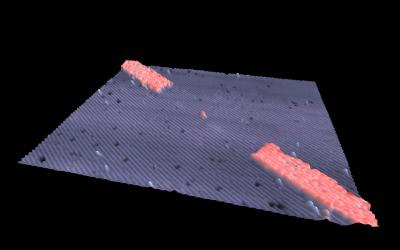Researchers Create Single-Atom Transistor
A report from the University of New South Wales provides reason to believe that Moore's Law has plenty of time left.
UNSW physicists were able to use a single phosphorus atom as a transistor that was placed between "atomic-scale electrodes and electrostatic control gates". To exactly position atoms on a chip is a critical ability to build quantum computers, the scientists said.
The team used a scanning tunnelling microscope to monitor and move atoms on the surface of a silicon crystal that was put in an ultra-high vacuum chamber. The phosphorus atoms were positioned via a lithography process and then covered with a non-reactive layer of hydrogen. The researchers then removed the hydrogen atoms in specific locations using the microscope tip. The placement of the phosphorus atoms on the silicon surface was achieved via a chemical reaction. The researchers completed the transistor with a silicon layer and "alignment markers" that enabled them to apply an electrical charge.
The researchers said that the "electronic properties of the device were in excellent agreement with theoretical predictions for a single phosphorus atom transistor."
So far, it has not been possible to target a specific location and position an atom in that specific spot. "This device is perfect", said Michelle Simmons, group leader and director of the ARC Centre for Quantum Computation and Communication at UNSW. "This is the first time anyone has shown control of a single atom in a substrate with this level of precise accuracy." Previously scientists hoped that an atom would be present in the location they needed it.
Intel will be rolling out processors built in 22 nm this year. Transistors that reach an atom level are expected to be built in the 2020 time frame.
Get Tom's Hardware's best news and in-depth reviews, straight to your inbox.

Douglas Perry was a freelance writer for Tom's Hardware covering semiconductors, storage technology, quantum computing, and processor power delivery. He has authored several books and is currently an editor for The Oregonian/OregonLive.
-
theuniquegamer How possible with 1 atom. I think in few 5-10 years a single chip will contain 10s of trillions of transistors.Reply -
joytech22 Wow, think about it for a second..Reply
We are building things out of ATOMS.. ATOMS!!
You serious? I mean sure we have carbon nanotubes and stuff but just wow.
And soon computers transistors may even be based on single Atoms?
I think we are advancing pretty damn fast, I mean we took over this planet and affected it in multiple ways, carve parts of it to our liking..
ARGH it's just insane.. >.< Humans are too powerful. -
dontknownotsure joytech22Wow, think about it for a second..We are building things out of ATOMS.. ATOMS!!You serious? I mean sure we have carbon nanotubes and stuff but just wow.And soon computers transistors may even be based on single Atoms?I think we are advancing pretty damn fast, I mean we took over this planet and affected it in multiple ways, carve parts of it to our liking..ARGH it's just insane.. >.< Humans are too powerful.Reply
oh just wait until they decide to play fallout IRL -
back_by_demand Arthur C Clarke wrote in the book 3001 that the race that invented the Monolith had found a way to store information by manipulating the fabric of spaceReply
...
At this rate we won't have to wait a thousand years for that to happen for real -
bustapr thats around 100x smaller than intels trigate transistors. Imagine the speed!Reply
also now that this is possible I fear well hit a wall in tech dev in the next 2 decades. -
software is equaly important as hardware.Reply
look at why AMD is falling behind in CPU, also they are gradualy loosing to nvidia in terms of features.
we need good software for good hardware.... bulldozer, was fail. dont know if its fixed yet nor do i care, I wont buy such a POS underperforming cpu.
point is hardware goes only sofar, software also needs to step in to make a great difference.
